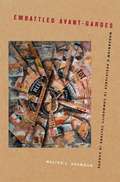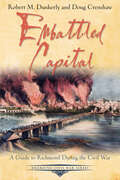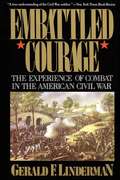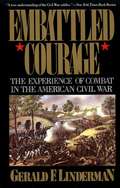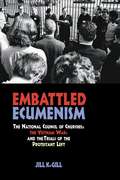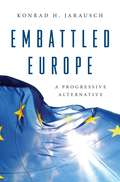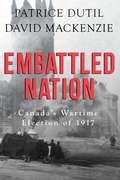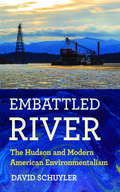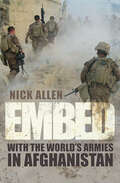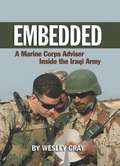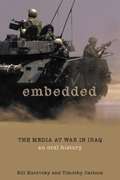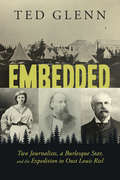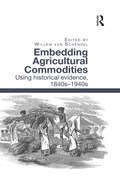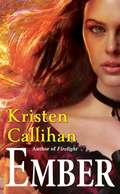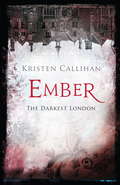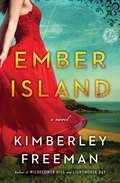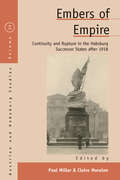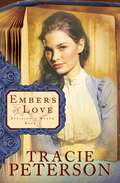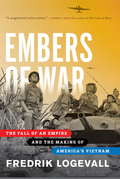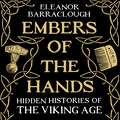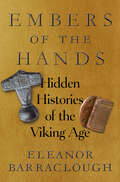- Table View
- List View
Embattled Avant-Gardes: Modernism's Resistance to Commodity Culture in Europe
by Walter AdamsonThis book provides a bold new perspective on a movement that defined the cultural landscape of the early twentieth century. Walter L. Adamson embarks on a lucid, wide-ranging exploration of the avant-garde practices through which the modernist generations coming after 1900 resisted the rise of commodity culture as a threat to authentic cultural expression.
Embattled Capital: A Guide to Richmond During the Civil War (Emerging Civil War Series)
by Robert M. Dunkerly Doug CrenshawA guide to the former Confederate capital of Richmond, Virginia, with “a good deal of historical information, much of it neglected in histories of the war” (The NYMAS Review).“On To Richmond!” cried editors for the New York Tribune in the spring of 1861. Thereafter, that call became the rallying cry for the North’s eastern armies as they marched, maneuvered, and fought their way toward the capital of the Confederacy.Just 100 miles from Washington, DC, Richmond served as a symbol of the rebellion itself. It was home to the Confederate Congress, cabinet, president, and military leadership. And it housed not only the Confederate government but also some of the Confederacy’s most important industry and infrastructure. The city was filled with prisons, hospitals, factories, training camps, and government offices.Through four years of war, armies battled at its doorsteps—and even penetrated its defenses. Civilians felt the impact of war in many ways: food shortages, rising inflation, a bread riot, industrial accidents, and eventually, military occupation. To this day, the war’s legacy remains deeply written into the city and its history.This book tells the story of the Confederate capital before, during, and after the Civil War, and serves as a guidebook including a comprehensive list of places to visit: the battlefields around the city, museums, historic sites, monuments, cemeteries, historical preservation groups, and more.
Embattled Courage
by Gerald LindermanLinderman traces each soldier's path from the exhilaration of enlistment to the disillusionment of battle to postwar alienation. He provides a rare glimpse of the personal battle that raged within soldiers then and now.
Embattled Courage: The Experience of Combat in the American Civil War
by Gerald F. LindermanLinderman traces each soldier's path from the exhilaration of enlistment to the disillusionment of battle to postwar alienation. He provides a rare glimpse of the personal battle that raged within soldiers then and now.
Embattled Ecumenism: The National Council of Churches, the Vietnam War, and the Trials of the Protestant Left
by Jill K. GillThe Vietnam War and its polarizing era challenged, splintered, and changed The National Council of the Churches of Christ in the U. S. A. (NCC), which was motivated by its ecumenical Christian vision to oppose that war and unify people. The NCC's efforts on the war exposed its strengths and imploded its weaknesses in ways instructive for religious institutions that bring their faith into politics. Embattled Ecumenism explores the ecumenical vision, anti-Vietnam War efforts, and legacy of the NCC. Gill's monumental study serves as a window into the mainline Protestant manner of engaging political issues at a unique time of national crisis and religious transformation. In vibrant prose, Gill illuminates an ecumenical institution, vision, and movement that has been largely misrepresented by the religious right, dismissed by the secular left, misunderstood by laity, and ignored by scholars outside of ecumenical circles. At a time when the majority of scholarly work is committed to looking at the religious right, Gill's groundbreaking study of the Protestant Left is a welcome addition. Embattled Ecumenism will appeal to scholars of U. S. religion, politics, and culture, as well as historians of evangelicalism and general readers interested in U. S. history and religion.
Embattled Europe: A Progressive Alternative
by Konrad H. JarauschA bracing corrective to predictions of the European Union’s decline, by a leading historian of modern EuropeIs the European Union in decline? Recent history, from the debt and migration crises to Brexit, has led many observers to argue that the EU’s best days are behind it. Over the past decade, right-wing populists have come to power in Poland, Hungary, and beyond—many of them winning elections using strident anti-EU rhetoric. At the same time, Russia poses a continuing military threat, and the rise of Asia has challenged the EU's economic power. But in Embattled Europe, renowned European historian Konrad Jarausch counters the prevailing pessimistic narrative of European obsolescence with a rousing yet realistic defense of the continent—one grounded in a fresh account of its post–1989 history and an intimate understanding of its twentieth-century horrors.An engaging narrative and probing analysis, Embattled Europe tells the story of how the EU emerged as a model of democratic governance and balanced economic growth, adapting to changing times while retaining its value system. The book describes the EU’s admirable approach to the environment, social welfare, immigration, and global competitiveness. And it presents underappreciated European success stories—including Denmark’s transition to a green economy, Sweden’s restructuring of its welfare state, and Poland’s economic miracle.Embattled Europe makes a powerful case that Europe—with its peaceful foreign policy, social welfare solidarity, and environmental protection—offers the best progressive alternative to the military adventurism and rampant inequality of plutocratic capitalism and right-wing authoritarianism.
Embattled Freedom: Journeys through the Civil War’s Slave Refugee Camps (Civil War America)
by Amy Murrell TaylorThe Civil War was just days old when the first enslaved men, women, and children began fleeing their plantations to seek refuge inside the lines of the Union army as it moved deep into the heart of the Confederacy. In the years that followed, hundreds of thousands more followed in a mass exodus from slavery that would destroy the system once and for all. Drawing on an extraordinary survey of slave refugee camps throughout the country, Embattled Freedom reveals as never before the everyday experiences of these refugees from slavery as they made their way through the vast landscape of army-supervised camps that emerged during the war. Amy Murrell Taylor vividly reconstructs the human world of wartime emancipation, taking readers inside military-issued tents and makeshift towns, through commissary warehouses and active combat, and into the realities of individuals and families struggling to survive physically as well as spiritually. Narrating their journeys in and out of the confines of the camps, Taylor shows in often gripping detail how the most basic necessities of life were elemental to a former slave's quest for freedom and full citizenship.The stories of individuals--storekeepers, a laundress, and a minister among them--anchor this ambitious and wide-ranging history and demonstrate with new clarity how contingent the slaves' pursuit of freedom was on the rhythms and culture of military life. Taylor brings new insight into the enormous risks taken by formerly enslaved people to find freedom in the midst of the nation's most destructive war.
Embattled Nation: Canada's Wartime Election of 1917
by David Mackenzie Patrice DutilEmbattled Nation explores Canada’s tense wartime election of 1917. Amidst the drama of the First World War, Canada’s most divisive election ever raised pivotal questions about Canada’s place in the war and the world. This book examines the issues, people, and events behind one of the most important elections in Canada’s history.
Embattled Rebel: Jefferson Davis and the Confederate Civil War
by James M. McphersonFrom the Pulitzer Prize-winning author of Battle Cry of Freedom, a powerful new reckoning with Jefferson Davis as military commander of the Confederacy History has not been kind to Jefferson Davis. Many Americans of his own time and in later generations considered him an incompetent leader, not to mention a traitor. Not so, argues James M. McPherson. In Embattled Rebel, McPherson shows us that Davis might have been on the wrong side of history, but that it is too easy to diminish him because of his cause's failure. Gravely ill throughout much of the Civil War, Davis nevertheless shaped and articulated the principal policy of the Confederacy--the quest for independent nationhood--with clarity and force. He exercised a tenacious hands-on influence in the shaping of military strategy, and his close relationship with Robert E. Lee was one of the most effective military-civilian partnerships in history.Lucid and concise, Embattled Rebel presents a fresh perspective on the Civil War as seen from the desk of the South's commander in chief.From the Trade Paperback edition.ive in American history exercised such tenacious hands-on influence in the shaping of military strategy. And while he was imprisoned for two years after the Confederacy's surrender awaiting a trial for treason that never came, and lived for another twenty-four years, he never once recanted the cause for which he had fought and lost. McPherson gives us Jefferson Davis as the commander in chief he really was, showing persuasively that while Davis did not win the war for the South, he was scarcely responsible for losing it.
Embattled River: The Hudson and Modern American Environmentalism
by David SchuylerIn Embattled River, David Schuyler describes the efforts to reverse the pollution and bleak future of the Hudson River that became evident in the 1950s. Through his investigative narrative, Schuyler uncovers the critical role of this iconic American waterway in the emergence of modern environmentalism in the United States.Writing fifty-five years after Consolidated Edison announced plans to construct a pumped storage power plant at Storm King Mountain, Schuyler recounts how a loose coalition of activists took on corporate capitalism and defended the river. As Schuyler shows, the environmental victories on the Hudson had broad impact. In the state at the heart of the story, the immediate result was the creation in 1970 of the New York State Department of Environmental Conservation to monitor, investigate, and litigate cases of pollution. At the national level, the environmental ferment in the Hudson Valley that Schuyler so richly describes contributed directly to the creation of the Environmental Protection Agency in 1970, the passage of the Clean Water Act in 1972, and the creation of the Superfund in 1980 to fund the cleanup of toxic-dumping sites.With these legal and regulatory means, the contest between environmental advocates and corporate power has continued well into the twenty-first century. Indeed, as Embattled River shows, the past is prologue. The struggle to control the uses and maintain the ecological health of the Hudson River persists and the stories of the pioneering advocates told by Schuyler provide lessons, reminders, and inspiration for today's activists.
Embattled: How Ancient Greek Myths Empower Us to Resist Tyranny
by Emily Katz AnhaltAn incisive exploration of the way Greek myths empower us to defeat tyranny. As tyrannical passions increasingly plague twenty-first-century politics, tales told in ancient Greek epics and tragedies provide a vital antidote. Democracy as a concept did not exist until the Greeks coined the term and tried the experiment, but the idea can be traced to stories that the ancient Greeks told and retold. From the eighth through the fifth centuries BCE, Homeric epics and Athenian tragedies exposed the tyrannical potential of individuals and groups large and small. These stories identified abuses of power as self-defeating. They initiated and fostered a movement away from despotism and toward broader forms of political participation. Following her highly praised book Enraged: Why Violent Times Need Ancient Greek Myths, the classicist Emily Katz Anhalt retells tales from key ancient Greek texts and proceeds to interpret the important message they hold for us today. As she reveals, Homer's Iliad and Odyssey, Aeschylus's Oresteia, and Sophocles's Antigone encourage us—as they encouraged the ancient Greeks—to take responsibility for our own choices and their consequences. These stories emphasize the responsibilities that come with power (any power, whether derived from birth, wealth, personal talents, or numerical advantage), reminding us that the powerful and the powerless alike have obligations to each other. They assist us in restraining destructive passions and balancing tribal allegiances with civic responsibilities. They empower us to resist the tyrannical impulses not only of others but also in ourselves. In an era of political polarization, Embattled demonstrates that if we seek to eradicate tyranny in all its toxic forms, ancient Greek epics and tragedies can point the way.
Embed: To the End With the World's Armies in Afghanistan
by Nick AllenIn 2007, journalist Nick Allen quit a secure job in Pakistan as a news agency writer to experience the life of foreign troops fighting the Taliban in Afghanistan. Over several years he journeyed as an embedded reporter with a dozen armies, working his way through placid backwaters to remote, savage hotspots where daily clashes with insurgent forces were the norm.Driven by a desire to himself live and then convey some of the drama, tragedy, farce and sheer frustration experienced by soldiers and marines from California to Copenhagen, Allen returned again and again for ‘embeds’ with different contingents to explore a multinational effort that will surely define NATO’s future and events in South Asia, and the world, for many years to come. No other writer managed to gain such broad access to the forty-two-country Coalition that was deployed in Afghanistan, or produce an account that carries so much of the essence of soldiering in this inhospitable environment, where extremes of climate, treachery and enemy cunning have always defeated nations that dared to wage war in the ‘graveyard of empires.’Embed explores the fragile calm of Bamiyan and its ancient sites and other low-intensity regions – usually ignored but a vital part of the overall picture – together with the ferocious clashes of Helmand, Kandahar, Kunar and other provinces. The author found that even the most sophisticated armed forces had been sucked into a fight they were ill-prepared for and, amid political uncertainty and dwindling public support back home, ultimately could not win.
Embedded
by Wesley R. GrayIn 2006, 1st Lt. Wesley Gray was deployed as a U.S. Marine Corps military adviser to an Iraqi Army battalion in the Haditha Triad. For 210 days, he lived and fought beside Iraqi soldiers in the most dangerous and austere province of western Iraq. Al-Anbar was filled with an insurgent population traumatized by a recent massacre of twenty-four men, women, and children shot at close range by U.S. Marines in retaliation for the death of one of their comrades in a roadside bombing. Despite the high tensions created by the shootings, Gray was able to form a bond with the Iraqis because he had an edge that very few U.S. service members possess -the ability to communicate in Iraqi Arabic. His language skills and his understanding of the culture led the Iraqi soldiers to call him a brother and fondly name him Jamal. By the end of his tour he was a legend within the Iraqi Army. Gray draws on the brutally honest and detailed record he kept during his tour, including extensive interviews with Iraqi soldiers and citizens. He offers a comprehensive portrait of the struggles of the Iraqi people to make their country a nation once again and includes a compelling report on the status and prospects of the U.S. government's strategy for success in Iraq.
Embedded: The Media At War in Iraq
by Bill Katovsky Timothy Carlson<P>EMBEDDED is a collection of deeply emotional and highly personal accounts of covering the Iraq War. Many of the world's top war correspondents and photographers speak candidly about life on the battlefield. Here are articulate and heartfelt descriptions of fear and firefights, of bullets and banalities, of risking death and meeting deadlines. <P>With over sixty interviews conducted in Kuwait and Iraq shortly after many returned home, Katovsky and Carlson allowed these journalists to step outside their professional role as journalists and examine the lethal allure of combat reporting. <P>Here is CBS Evening News correspondent Jim Axelrod discussing the perils of racing to Baghdad while despondent over the death of a television colleague and being unexpectedly comforted by ABC News Nightline's Ted Koppel; Newsweek reporter Scott Johnson unwittingly driving into an ambush and then kicking out the windshield of his bullet-riddled car to escape the Iraqi gunmen; New York Times Baghdad Bureau Chief John Burns's brave refusal to be intimidated by his Iraqi information ministry minders; and many, many more. <P>Each interview in EMBEDDED maps its own personal path and narrative arc, while presenting an emotional window to war and reporting. Taken individually, each offers a unique view of the most-covered war in history. Collectively, EMBEDDED is an eyewitness to history that will do for the war in Iraq what Michael Herr's Dispatches did for Vietnam.
Embedded: Two Journalists, a Burlesque Star, and the Expedition to Oust Louis Riel
by Ted GlennA first-hand chronicle of Wolseley’s expedition to end Riel’s Red River Rebellion by a remarkable trio embedded on the mission. In the spring of 1870, two reporters set off from Toronto to cover one of the biggest stories in Canadian history: Colonel Garnet Wolseley’s 1870 expedition to Red River. Over the course of six months, the Daily Telegraph’s Robert Cunningham and the Globe’s Molyneux St. John brought readers along as they paddled and portaged alongside the expedition’s 1,100 troops and 400 voyageurs and guides from the shores of Lake Superior to Fort Garry.But that’s not the whole story. Buried well below the fold was the fact that St. John’s wife — international burlesque star Kate Ranoe — accompanied him and the expedition, and not just as an adventurer. Owing to an accident early on, Ranoe ended up ghostwriting many of St. John’s stories. Embedded is the remarkable story of two reporters and one extraordinary woman as they journeyed to Red River with Colonel Garnet Wolseley and his expeditionary force.
Embedding Agricultural Commodities: Using historical evidence, 1840s–1940s
by Willem Van SchendelOver the past 500 years westerners have turned into avid consumers of colonial products and various production systems in the Americas, Africa and Asia have adapted to serve the new markets that opened up in the wake of the "European encounter". The effects of these transformations for the long-term development of these societies are fiercely contested. How can we use historical source material to pinpoint this social change? <P><P>This volume presents six different examples from countries in which commodities were embedded in existing production systems - tobacco, coffee, sugar and indigo in Indonesia, India and Cuba - to shed light on this key process in human history. To demonstrate the effectiveness of using different types of source material, each contributor presents a micro-study based on a different type of historical source: a diary, a petition, a "mail report", a review, a scientific study and a survey. As a result, the volume offers insights into how historians use their source material to construct narratives about the past and offers introductions to trajectories of agricultural commodity production, as well as much new information about the social struggles surrounding them.
Ember
by Kristen Callihan"Callihan has a great talent for sexual tension and jaw-dropping plots that weave together brilliantly in the end."--- Diana Gabaldon, New York Times bestselling authorAfter a fire consumes the Ellis family fortune, the beautiful and resourceful Miranda finds herself faced with an impossible dilemma: enter a life of petty crime or watch her family succumb to poverty. But once her fiancée learns of her descent into danger--and of the strange, new powers she's discovered --saving her family may come at the high price of her heart. When Lord Benjamin Archer's one chance for redemption is destroyed by corrupt London antiquarian Hector Ellis, he vows to take what Ellis values most-his daughter Miranda. Forced to hide his face behind masks, Archer travels the world hoping to escape the curse that plagues him so that he can finally claim his prize.But once Archer returns home to London, will it be revenge he seeks? Or will the flame-haired beauty ignite new, undeniable desires? Word Count: 21,850 words.
Ember (Darkest London #1)
by Kristen CallihanAfter a fire consumes the Ellis family fortune, the beautiful and resourceful Miranda finds herself facedwith an impossible dilemma: enter a life of petty crime or watch her family succumb to poverty. But once herfiancée learns of her descent into danger - and of the strange, new powers she's discovered - saving herfamily may come at the high price of her heart. When Lord Benjamin Archer's one chance for redemption is destroyed by his enemy, Hector Ellis, he vows to take what Ellis values most - his daughter Miranda. Forced to hide his face behind masks, Archer travels the world hoping to escape the curse that plagues him so that he can finally claim his prize. But once Archer returns home to London, will it be revenge he seeks? Or will the flame-haired beauty ignite new, undeniable desires?For fans of Diana Gabaldon, Cassandra Clare, Amanda Quick and Gail CarrigerPraise for Kristen Callihan:'Callihan has a great talent for sexual tension and jaw-dropping plots that weave together brilliantly in the end.' Diana Gabaldon 'Evocative and deeply romantic, fascinating from the very first page.' Nalini Singh"A sizzling paranormal with dark history and explosive magic! Callihan is an impressive new talent." Larissa Ione
Ember Island: A Novel
by Kimberley FreemanIn 1891, Tilly Kirkland is reeling with shock and guilt after her tempestuous marriage ends in horrific circumstances. Fleeing to the farthest place she knows, Tilly takes a job on Ember Island in Moreton Bay, Australia, where she becomes the governess to the prison superintendent's precocious young daughter, Nell. Tilly knows she must keep the past hidden in order to start a new life, but she doesn't know that Nell is watching her every move and writing it all down, hiding tiny journals all over their rambling manor home. More than one hundred years later, bestselling novelist Nina Jones is struggling to complete her next book. A reporter asking questions about her great-grandmother sends Nina retreating to her family's home on Ember Island, where she hopes to find her lost inspiration somewhere in the crumbling walls. Though they are separated by years, both Tilly and Nina must learn that some secrets never stay buried, but what matters most is learning to trust your heart. poet boyfriend has recently broken up with her, and a reporter who is digging into her past insists on speaking to Nina about her great-grandmother, Nell. There are some secrets Nina may no longer be able to hide. Retreating to Starwater, she discovers Nell's diary pages hidden in the old walls and becomes determined to solve the mystery. Though Tilly and Nina are separated by many years, Starwater House will change both their lives. Deeply affecting and beautifully written, Ember Island is a sweeping novel of secrets, second chances, and learning to trust your heart.
Embers of Empire: Continuity and Rupture in the Habsburg Successor States after 1918 (Austrian and Habsburg Studies #22)
by Paul Miller Claire MorelonThe collapse of the Habsburg Monarchy at the end of World War I ushered in a period of radical change for East-Central European political structures and national identities. Yet this transformed landscape inevitably still bore the traces of its imperial past. Breaking with traditional histories that take 1918 as a strict line of demarcation, this collection focuses on the complexities that attended the transition from the Habsburg Empire to its successor states. In so doing, it produces new and more nuanced insights into the persistence and effectiveness of imperial institutions, as well as the sources of instability in the newly formed nation-states.
Embers of Love (Striking a Match #1)
by Tracie PetersonThe logging industry in eastern Texas is booming, and Deborah Vandermark plans to assist her family's business now that she's completed college. Unexpectedly, her best friend, Lizzie Decker, accompanies her back home--fleeing a wedding and groom she has no interest in. Deborah, the determined matchmaker, puts her sights on uniting her brother and dear friend in a true love match. Deborah soon meets Dr. Christopher Clayton, a much-needed addition to the town. As their lives intersect, Deborah realizes that she has a much greater interest in medicine and science than the bookkeeping she was trained in. But when typhoid begins to spread and Lizzie's jilted fiance returns, Deborah wonders if true love can overcome such obstacles. . . for those dearest to her, and for herself.
Embers of Time
by Eugenia RileyIn the aftermath of World War II, an RAF pilot and a young Army nurse are destined to meet in Charleston, South Carolina. Each has known devastating loss: the death of a beloved child in a recent, tragic fire. The two join together to solve a mysterious disappearance and forge a love that breaks the bonds of time.
Embers of War: The Fall of an Empire and the Making of America's Vietnam
by Fredrik LogevallThe struggle for Vietnam occupies a central place in the history of the twentieth century. Fought over a period of three decades, the conflict drew in all the world's powers and saw two of them--first France, then the United States--attempt to subdue the revolutionary Vietnamese forces. For France, the defeat marked the effective end of her colonial empire, while for America the war left a gaping wound in the body politic that remains open to this day. How did it happen? Tapping into newly accessible diplomatic archives in several nations and making full use of the published literature, distinguished scholar Fredrik Logevall traces the path that led two Western nations to lose their way in Vietnam. Embers of War opens in 1919 at the Versailles Peace Conference, where a young Ho Chi Minh tries to deliver a petition for Vietnamese independence to President Woodrow Wilson. It concludes in 1959, with a Viet Cong ambush on an outpost outside Saigon and the deaths of two American officers whose names would be the first to be carved into the black granite of the Vietnam Veterans Memorial. In between come years of political, military, and diplomatic maneuvering and miscalculation, as leaders on all sides embark on a series of stumbles that makes an eminently avoidable struggle a bloody and interminable reality. Logevall takes us inside the councils of war--and gives us a seat at the conference tables where peace talks founder. He brings to life the bloodiest battles of France's final years in Indochina--and shows how from an early point, a succession of American leaders made disastrous policy choices that put America on its own collision course with history: Harry Truman's fateful decision to reverse Franklin Delano Roosevelt's policy and acknowledge France's right to return to Indochina after World War II; Dwight Eisenhower's strenuous efforts to keep Paris in the fight and his escalation of U.S. involvement in the aftermath of the humiliating French defeat at Dien Bien Phu; and the curious turnaround in Senator John F. Kennedy's thinking that would lead him as president to expand that commitment, despite his publicly stated misgivings about Western intervention in Southeast Asia. An epic story of wasted opportunities and tragic miscalculations, featuring an extraordinary cast of larger-than-life characters, Embers of War delves deep into the historical record to provide hard answers to the unanswered questions surrounding the demise of one Western power in Vietnam and the arrival of another. This book will become the definitive chronicle of the struggle's origins for years to come.Advance praise for Embers of War "Fredrik Logevall has gleaned from American, French, and Vietnamese sources a splendid account of France's nine-year war in Indochina and the story of how the American statesmen of the period allowed this country to be drawn into the quagmire."--Neil Sheehan, author of A Bright Shining Lie, winner of the Pulitzer Prize and the National Book Award "Fredrik Logevall is a wonderful writer and historian. In his new book on the origins of the American war in Vietnam, he gives a fascinating and dramatic account of the French war and its aftermath, from the perspectives of the French, the Vietnamese, and the Americans. Using previously untapped sources and a deep knowledge of diplomatic history, Logevall shows to devastating effect how America found itself on the road to Vietnam."--Frances FitzGerald, author of Fire in the Lake, winner of the Pulitzer Prize and the National Book Award
Embers of the Hands: Hidden Histories of the Viking Age
by Eleanor BarracloughImagine a Viking, and a certain image springs to mind: a nameless, faceless warrior, leaping ashore from a longboat, and ready to terrorise the hapless local population of a northern European country.Yet while such characters define the Viking Age today, they were in the minority. This is the history of all the other people - children, enslaved people, seers, artisans, travellers, writers - who inhabited the medieval Nordic world. Encompassing not just Norway, Denmark and Sweden, but also Iceland, Greenland, parts of the British Isles, Continental Europe and Russia, this is a history of a Viking Age filled with real people of different ages, genders and ethnicities, as told through the traces that they left behind, from hairstyles to place names, love-notes to gravestones.For the first time, you can immerse yourself in the day-to-day lives of extraordinary culture which spanned centuries and spread from the edge of the North American continent to the Russian steppes, from the Arctic wastelands to the Byzantine Empire and the Islamic Caliphate.
Embers of the Hands: Hidden Histories of the Viking Age
by Eleanor BarracloughA Kirkus Reviews Best Nonfiction Book of 2024 A Kirkus Reviews Editor's Pick A “brilliantly written, brilliantly conceived” (Tom Holland) history of the Viking Age, from mighty leaders to rebellious teenagers, told through their runes and ruins, games and combs, trash and treasure. In imagining a Viking, a certain image springs to mind: a barbaric warrior, leaping ashore from a longboat, and ready to terrorize the hapless local population of a northern European town. Yet while such characters define our imagination of the Viking Age today, they were in the minority. Instead, in the time-stopping soils, water, and ice of the North, Eleanor Barraclough excavates a preserved lost world, one that reimagines a misunderstood society. By examining artifacts of the past—remnants of wooden gaming boards, elegant antler combs, doodles by imaginative children and bored teenagers, and runes that reveal hidden loves, furious curses, and drunken spouses summoned home from the pub—Barraclough illuminates life in the medieval Nordic world as not just a world of rampaging warriors, but as full of globally networked people with recognizable concerns. This is the history of all the people—children, enslaved people, seers, artisans, travelers, writers—who inhabited the medieval Nordic world. Encompassing not just Norway, Denmark, and Sweden, but also Iceland, Greenland, the British Isles, Continental Europe, and Russia, this is a history of a Viking Age filled with real people of different ages, genders, and ethnicities, as told through the traces that they left behind. “Embers of the hands” is a poetic kenning from the Viking Age that referred to gold. But no less precious are the embers that Barraclough blows back to life in this book—those of ordinary lives long past.
